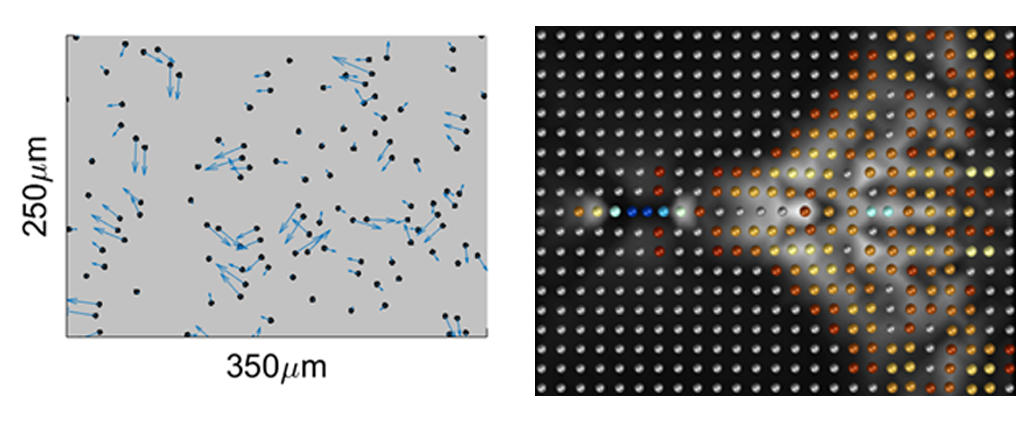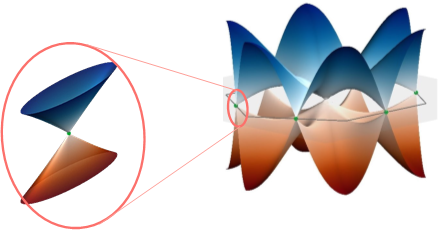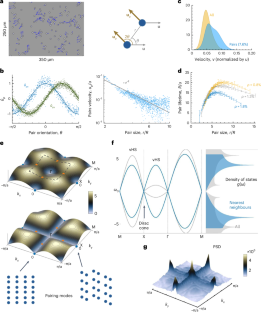古典的な準粒子の最初の例、量子散逸系と古典散逸系の深いつながりが明らかに First example of classical quasiparticles, revealing deep links between quantum and classical dissipative systems
2023-01-27 韓国基礎科学研究院(IBS)
◆準粒子は量子物理学にのみ存在するという標準的な考え方は、最近、韓国の基礎科学研究所(IBS)ソフト・リビング物質研究センター(CSLM)の研究グループによって覆された。研究者らは、マイクロ流体チャンネル内の粘性流によって駆動される微粒子からなる古典的なシステムを調べた。粒子は流れに引きずられると、周囲の流線を乱し、それによって互いに流体力学的な力を及ぼし合う。
◆研究者らは、この長距離の力によって、粒子が対になって組織化されることを見いだした(図1左)。これは、流体力学的相互作用によって、ニュートンの第三法則(2つの粒子間の力は大きさが等しく、方向が反対でなければならない)が破られたためである。その代わり、力は等しく同じ方向に働くので「反ニュートン的」であり、その結果、ペアは安定するのである。
◆ペアで結合している粒子の個数が多いことから、これらが系内の長寿命な素励起、つまり準粒子であることが示唆された。この仮説は、数千個の粒子からなる大きな二次元結晶をシミュレーションし、その運動を調べたところ、正しかったことが証明された(図1右)。粒子間の流体力学的な力によって、結晶は、振動する固体中の熱フォノンと同じように振動する。
◆この準粒子は結晶中を伝播し、連鎖反応によって他のペアを生成させる。準粒子はフォノンの速度よりも速く伝搬するため、超音速ジェット機の後ろにできるマッハコーンのように、すべての対が新しくできた対の雪崩を残していく(図1右)。そして最後に、これらの対がすべて互いに衝突し、最終的に結晶の融解に至るのです(動画)。
◆ペアによる融解は、六方晶を除くすべての対称性の結晶で観察されます。この場合、流体力学的相互作用の3回対称性が結晶の対称性と一致し、その結果、素励起は極めて遅い低周波フォノン(通常のペアではない)となります。スペクトルでは、これらの超低速フォノンが凝縮した「平坦バンド」が見られる。フラットバンドフォノン間の相互作用は非常に集団的で相関があり、それがよりシャープで異なるクラスの融解転移に表れているのです。
◆注目すべきは、フォノンのスペクトルを解析したところ、グラフェンの電子スペクトルに見られるような、ディラック準粒子に典型的な円錐状の構造が確認されたことである(図2)。流体力学的結晶の場合、ディラック準粒子は単なる粒子対であり、流れが媒介する「反ニュートン」相互作用によって形成されるものであることがわかった。このことは、この系が、グラフェンで発見された粒子の古典的なアナログとして機能することを示している。

図1. 左:細いマイクロ流路内で駆動するコロイド粒子の実験的測定。粒子は安定した流体力学的に結合したペアを形成し、同じ速度で移動している(矢印)。これらのペアは、システムの基本的な準粒子である。右図。流体力学的結晶のシミュレーション。準粒子ペア(左端の黄色とオレンジの粒子)が流体力学的結晶中を伝播し、励起された準粒子の超音速マッハコーンを残していく様子を示している。色はペアの励起の大きさを表し、白い背景はその速度を表しています(動画参照)。

図2. 流体力学的結晶中のフォノンのスペクトルはディラック・コーンを示し、準粒子対の発生を現している。ズームはディラック・ダブルコーンの一つを示す。

動画で見る 準粒子なだれ。孤立した対の準粒子がある完全な正方形の格子から出発したシミュレーション(右中央)。この対は、後続のマッハコーンにある対の雪崩を励起しながら左へ伝搬します。励起された対の衝突により融解が起こる。白い矢印は速度を、粒子の色は各準粒子ペアの2つの粒子間の距離を示している。
<関連情報>
- https://www.ibs.re.kr/cop/bbs/BBSMSTR_000000000738/selectBoardArticle.do?nttId=22468&pageIndex=1&searchCnd=&searchWrd=
- https://www.nature.com/articles/s41567-022-01893-5
準粒子、フラットバンド、流体力学的物質の融解 Quasiparticles, flat bands and the melting of hydrodynamic matter
Imran Saeed,Hyuk Kyu Pak & Tsvi Tlusty
Nature Physics Published:26 January 2023
DOI:https://doi.org/10.1038/s41567-022-01893-5

Abstract
The concept of quasiparticles—long-lived low-energy particle-like excitations—has become a cornerstone of condensed quantum matter, where it explains a variety of emergent many-body phenomena such as superfluidity and superconductivity. Here we use quasiparticles to explain the collective behaviour of a classical system of hydrodynamically interacting particles in two dimensions. In the disordered phase of this matter, measurements reveal a subpopulation of long-lived particle pairs. Modelling and simulation of the ordered crystalline phase identify the pairs as quasiparticles, emerging at the Dirac cones of the spectrum. The quasiparticles stimulate supersonic pairing avalanches, bringing about the melting of the crystal. In hexagonal crystals, where the intrinsic three-fold symmetry of the hydrodynamic interaction matches that of the crystal, the spectrum forms a flat band dense with ultra-slow, low-frequency phonons whose collective interactions induce a much sharper melting transition. Altogether, these findings demonstrate the usefulness of concepts from quantum matter theory in understanding many-body physics in classical dissipative settings.



